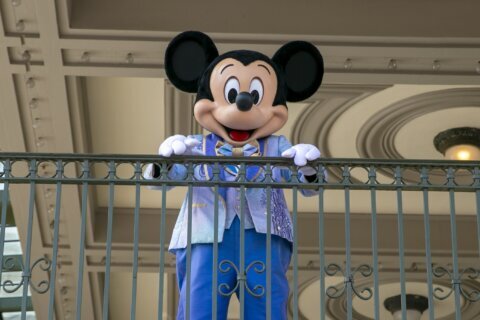She is one of the most important figures ever in comedy, not only the first woman to host a sketch variety show, but the namesake of the Golden Globe for Life Achievement in Television.
This month, you can join Carol Burnett for “An Evening of Laughter & Reflection” at the Modell Lyric in Baltimore on July 23 and Strathmore in Bethesda on July 25.
“It’s a conversation with the audience the way I used to open my show,” Burnett told WTOP. “I start by showing eight or nine minutes from my favorite Q&As from the show. That gets the audience acquainted with how the evening is going to go, then I come out, we bump up the lights and we have ushers with microphones. … It keeps the old gray matter ticking! I can’t be thinking about what I did yesterday or what I might do tomorrow, I have to be in the now.”
What types of questions does she typically get?
“The most common questions are: ‘Why did you pull your ear at the end of the show?’ ‘Do the Tarzan yell! How did that come about?’ ‘Was Tim Conway as funny in real life as he was in the show?’ ‘How did you find Vicki and Harvey?’ Things like that. I really enjoy it,” Burnett said.
Born in San Antonio, Texas in 1933, Burnett moved with her grandmother to Hollywood, California where she remembers going to the movies constantly as a kid.
“We were poor, but we’d save our pennies,” Burnett said. “In the ’40s and ’50s, movies didn’t cost that much. For my grandmother it was a quarter and for me, until I turned 12, it was a dime. … They would have double features, so you could see two movies for the price of one. On a weekend, we might see two on Saturday, two on Sunday, then on Wednesdays there would be Keno night. I would see as many as four to six to eight movies a week growing up.”
Which movies did she love growing up?
“I loved all the musicals: Gene Kelly, Mickey [Rooney], Judy [Garland], Betty Grable and Rita Hayworth,” Burnett said. “When I was growing up, the movies were not cynical. The bad guys lost, the good guys won, there was no gray area. It was an imprint on me, which I think saved me. If Mickey and Judy put on a show in their barn, it was inevitable that it would wind up on Broadway. That’s the way the movies were! So when I went to New York, I didn’t know anyone. I’d never been further east than Texas, but I never felt like I couldn’t make it. I wanted to be in show business to pay the rent, put food on the table and clothes on my back. That was my goal.”
She began her journey at UCLA, switching pursuits from journalism to musical theater.
“They didn’t have a major in journalism, so I took the writing courses and I joined the school paper, but I was looking through the catalog and they had a theater arts major,” Burnett said. “As a freshman you had to take an acting course. That was the farthest thing from my mind. I was 18 and terrified! There were 14 of us in the class. I had to get up and do a monologue. I was terrible, but later on, I teamed up with a classmate on Noel Coward’s ‘Red Peppers,’ so I just pretended to be Betty Grable with a cockney accent. They laughed and the teacher gave us an ‘A,’ and all of a sudden I’m hearing people laugh. It was just the greatest feeling.”
The acting classes also inspired her to try out her musical chops.
“I got into the music department and they were doing ‘South Pacific,'” Burnett said. “I was one of the nurses in the chorus. I was so loud they took me out and the director said, ‘Would you do a scene with me from ‘Guys and Dolls’ and sing ‘Adelaide’s Lament?’ I was nervous about singing alone, but I looked at the song and in it, Miss Adelaide has a cold. I said, ‘Ooh! If I hit a clam, I can blame it on the character having a cold!’ Then my love was musical comedy. All of a sudden, boom, my whole life changed because there wasn’t a journalism major at UCLA.”
After college, she moved to New York, earning a Tony nomination for Broadway’s “Once Upon a Mattress” (1959). She also made her TV debut on “The Paul Winchell Show” (1955), earned an Emmy on “The Garry Moore Show” (1959-1962) and appeared on “The Jack Benny Program” (1962-1963), “The Lucy Show” (1966-1967) and CBS’ “Calamity Jane” (1963) in the title role.
“When I got my first job on television, I called my grandmother, Nanny, who raised me and I told her I was going to be on TV. I was in New York and she was in California. She said, ‘Say hello to me!’ I said, ‘Nanny, I don’t think they’re going to let me say, ‘Hi Nanny’ on television,’ but we cooked up this signal that I would tug on my left ear, which meant, ‘Hi Nanny, I love you.’ Later on, as I got more successful, it meant, ‘Hi Nanny, I love you, your check’s on the way.”
After a decade of sitcoms, she eventually got the itch to do her own variety show.
“I had a very strange, odd, unusual contract with CBS,” Burnett said. “I signed with them for 10 years where each year I would do a guest shot on a sitcom and a special. But there was a caveat, a clause in the contract that said within the first five years, if I wanted to push that button, CBS would have to put us on for 30 one-hour variety shows. I thought I’ll probably never do that, but toward the end of the fifth year, my husband and I had just moved to California and put a down payment on a house. We said, ‘Maybe we better push that button.'”
As a woman ahead of her time, she faced pushback from patriarchal network execs.
“I called the vice president and said, ‘I’m calling to push that button.’ … He said, ‘I see that Carol, but comedy-variety is a man’s game. It’s Sid Caesar, Milton Berle, Jackie Gleeson, Dean Martin. But we’d love you to do a sitcom called ‘Here’s Agnes.’ I said, ‘I don’t want to be Agnes every week. I want to have different costumes, be different characters, I want to have music, a rep company like Sid Caesar had, guest stars, dancers.’ … They didn’t have any faith in us at all. I wasn’t too sure myself, but we said, ‘At least we’ll get 30 shows out of it.’ Then it took off.”
Thus, “The Carol Burnett Show” was born, winning 28 Emmys and eight Golden Globes from 1967-1978 with Tim Conway, Harvey Korman, Vicki Lawrence and Lyle Waggoner.
“It was an ideal situation,” Burnett said. “We all got along — that’s very important. Even though my name is on it, ‘The Carol Burnett Show,’ it was a true rep company. We supported each other. There were many times I would support Tim in a sketch or Harvey would support Vicki. It was like summer stock. There were sketches where Tim was the star or Harvey or Vicki or me. Nobody hogged the limelight. We wanted everybody to score a touchdown.”
Fans loved when the cast broke character in laughing fits on set. Burnett lovingly blames the hilarious pranks of Conway, who just died earlier this summer.
“I miss him as a human being because he was as nice as he was funny,” Burnett said. “He was fearless. We would tape two shows on Friday with an audience. Tim would do it exactly the way we’d rehearsed it all week, then he’d go to the director and ask, ‘How did it go in the first show? Did you get all the shots?’ Then he would do stuff on the second show that we hadn’t seen him do. Nine times out of ten that’s what we used because it was pure gold. … I’ve often said, ‘Maybe there are people who are as funny as Tim, but there’s nobody more funny than Tim.'”
The cast also included the comic genius of Korman, as displayed in “Blazing Saddles” (1974).
“He was one of the most brilliantly comedic actors we’ve had,” Burnett said. “There was nothing he couldn’t do. He could imitate. We would do a lot of movie takeoffs and one of my favorite ones was Ronald Colman in ‘Random Harvest.’ He was Clark Gable in our ‘Gone with the Wind’ sketch. It was almost like he was channeling. There was no accent he couldn’t do. … If you want to learn to play a good tennis game, you want to play with a better tennis player. It only makes your game better. That’s what Harvey did for all of us. He made our game better.”
The youngest cast member was Lawrence, but she proved to be a quick learner.
“Vicki was 18 and had no professional experience. We really took a chance on her, but I felt there was something there. I turned out to be right. The first season, she was pretty shy, awkward and scared, but [Harvey] took her under his wing and taught her how to listen during a sketch and not just wait for your cue to speak, how to deal with props, accents. Vicki was a sponge. She ate it up and learned. She learned her craft in front of 30 million people.”
That includes the character Mama, who got her own spinoff in “Mama’s Family” (1983-1990).
“Our two writers, Dick Clair and Jenna McMahon, came up with that. I read it and said, ‘This is brilliant.’ It’s little one-acts, there were no jokes in it, it was all character driven. At first, they wrote Mama for me. … I said, ‘Eunice speaks to me. I think I can do Eunice better than I can do Mama.’ … Costume designer Bob Mackie said, ‘Let’s just put Vicki in a fat suit, take her eyelashes off, slap a gray wig on her and let her play Mama.’ It turned out to be the best idea ever.”
Last but not least, who can forget Waggoner as the show’s announcer turned performer?
“This was an idea that Carl Reiner had,” Burnett said. “He was a friend and said, ‘You oughta get a good-looking, hunky announcer that you can go ga-ga over the way I used to do on ‘The Garry Moore Show.’ If we had Robert Goulet or Peter Lawford on, they’d bring me out as this man-hungry kook. It was funny at the time, so we got a bunch of good-looking guys to audition. Lyle was very handsome but he also had a sense of humor, so he got the job. After a while, I stopped doing the ‘I’m in love with Lyle bit,’ because I was a grown woman with children. Instead, we started putting him in sketches. He turned out to be a very good sketch performer.”
They even added Dick Van Dyke for a brief run in the 11th and final season.
“At the end of the 11th season, they wanted us back for a 12th, but I felt that it was time to leave before I was asked to leave,” Burnett said. “We were doing OK, but in 11 years we just started kind of repeating ourselves a little bit and I felt it was time to move on. We had 11 wonderful, joy-filled years for which I am so grateful. Even today, I get fan mail from 10-year-olds and teenagers who watch us on YouTube or have bought DVDs and [watching reruns] on MeTV. The mail I get from young people or the comments on YouTube, it’s just amazing.”
The most famous sketch remains the “Gone with the Wind” spoof that aired on Nov. 13, 1976, in which Burnett roasted Scarlett O’Hara by hilariously wearing a curtain rod as her dress.
“The writers had written that I would run up the stairs and come down with the draperies hanging on me, just draped over my shoulders,” Burnett said. “Bob Mackie, the genius that he is, said, ‘That’s not that funny.’ So when I went into costume fitting that week, on a Wednesday morning, he said, ‘I have an idea for that curtain dress.’ I said, ‘What?’ I went into the dressing room and he had it on that curtain rod. I fell on the floor. I said, ‘This is going to be one of the funniest sight gags in the history of television,’ and it was. That was all Bob Mackie’s idea.”
She later pivoted into movies, including Billy Wilder’s “The Front Page” (1974), Robert Altman’s “A Wedding” (1978), Alan Alda’s “The Four Seasons” (1981) and Peter Bogdanovich’s “Noises Off” (1992), but her most famous remains Miss Hannigan in John Huston’s “Annie” (1982).
“He would do maybe one take and that would be it,” Burnett told WTOP in 2016. “He was very planned out. He knew exactly what he wanted. I don’t think we did more than two takes on a scene. One of my favorite pieces of direction he ever gave me was, the first day I was going to be shooting a scene, I went up to him and I said, ‘Mr. Huston, how do you want me to play this?’ … And he said, ‘Just cavort, dear. Just cavort.’”
In 2019, Golden Globes named a Lifetime Achievement Award after Burnett. Its film prize is the Cecil B. DeMille Award, while its television prize is now the Carol Burnett Award.
“What an honor,” Burnett said. “They said they were going to create the category, because they didn’t have one for Lifetime Achievement in Television. They were going to create it for this year and give it to me as the first recipient. Then they said, ‘No, we’re not only going to do that, we’re going to name it after you!’ I was totally gobsmacked. Wow! That was quite an honor.”
Fittingly, she ended her acceptance speech by tugging her ear to her late grandma.
“She’s long gone, but I still do it,” Burnett said with a warmth in her voice.
How else to end our interview than by tugging ears on opposite ends of the phone?
“Right back at you,” Burnett said.
Find more details on the Strathmore website. Hear my full conversation with Carol Burnett below:








